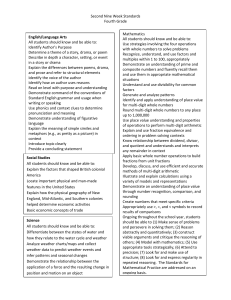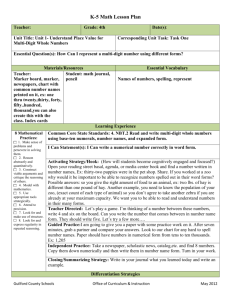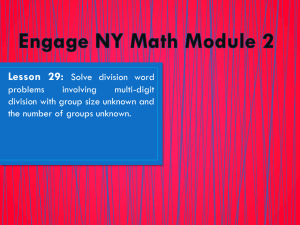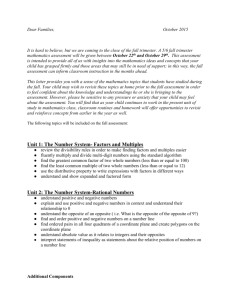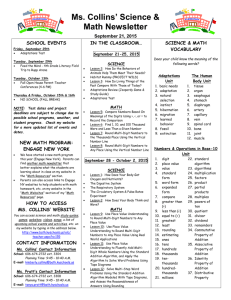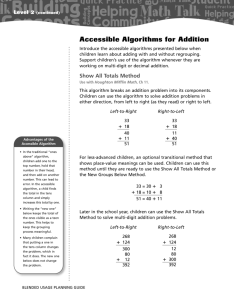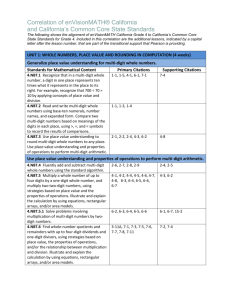2 - Great Minds
advertisement
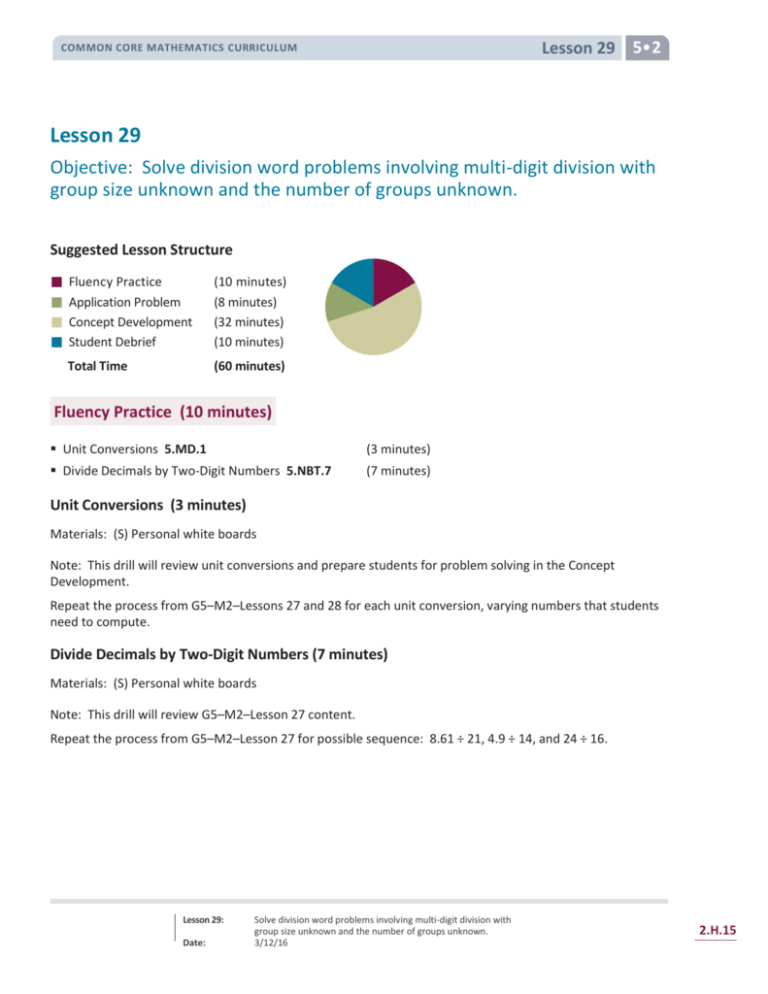
Lesson 29 5•2 COMMON CORE MATHEMATICS CURRICULUM Lesson 29 Objective: Solve division word problems involving multi-digit division with group size unknown and the number of groups unknown. Suggested Lesson Structure Fluency Practice Application Problem Concept Development Student Debrief Total Time (10 minutes) (8 minutes) (32 minutes) (10 minutes) (60 minutes) Fluency Practice (10 minutes) Unit Conversions 5.MD.1 (3 minutes) Divide Decimals by Two-Digit Numbers 5.NBT.7 (7 minutes) Unit Conversions (3 minutes) Materials: (S) Personal white boards Note: This drill will review unit conversions and prepare students for problem solving in the Concept Development. Repeat the process from G5–M2–Lessons 27 and 28 for each unit conversion, varying numbers that students need to compute. Divide Decimals by Two-Digit Numbers (7 minutes) Materials: (S) Personal white boards Note: This drill will review G5–M2–Lesson 27 content. Repeat the process from G5–M2–Lesson 27 for possible sequence: 8.61 ÷ 21, 4.9 ÷ 14, and 24 ÷ 16. Lesson 29: Date: Solve division word problems involving multi-digit division with group size unknown and the number of groups unknown. 3/12/16 2.H.15 COMMON CORE MATHEMATICS CURRICULUM Lesson 29 5•2 Application Problem (8 minutes) A one-year (52-week) subscription to a weekly magazine is $39.95. Greg calculates that he would save $219.53 if he subscribed to the magazine instead of purchasing it each week at the store. What is the price of the individual magazine at the store? Note: This Application Problem uses concepts from G5–Module 1 in the first step of the problem and division of decimals with group size unknown from Module 2 in the second step of the problem. A tape diagram or place value chart can be used to add the decimals and a tape diagram is the ideal strategy to represent the division. $259.48 ÷ 52 is best solved through estimation, as the dividend can be estimated as an easily identifiable multiple of 50. However, if it is deemed that more time is needed for Concept Development, the Application Problem may be used for homework or journal entry. Concept Development (32 minutes) Materials: (S) Problem Set Note: G5–M2–Lesson 29 is a continuation of the problem solving from G5–M2–Lesson 26. It is suggested that delivery of today’s lesson follow that of Lesson 28. It is also acceptable to allow students as much independence in solving as is appropriate for your particular student population. Problem 1 Lamar has 1354.5 kilograms of potatoes to deliver in equal amounts to 18 stores. 12 of the stores are in the Bronx. How many kilograms of potatoes will be delivered to stores in the Bronx? Before solving: T: Will the amount delivered to the stores in the Bronx be more or less than half of the total amount of potatoes delivered? How do you know? S: More than half because more than half of the stores are in the Bronx. Lesson 29: Date: Solve division word problems involving multi-digit division with group size unknown and the number of groups unknown. 3/12/16 2.H.16 COMMON CORE MATHEMATICS CURRICULUM Lesson 29 5•2 This two-step equal groups with group size unknown problem requires first dividing to find the value of one unit and then multiplying to find the value of 12 of those units. T: T: S: How can you know that your final answer is reasonable? Was the amount delivered to the Bronx stores more than half of the total? How did you determine if your decimal was placed reasonably in your product? I was multiplying by 12. I knew that my answer needed to be more than 750 but less than 7,500. The only place that made sense to put the decimal made the answer 903 – not 90.3 or 9,030. I mentally multiplied 75.25 by 100 to make it 7,525 hundredths before I multiplied by 12. I knew I needed to adjust my product by dividing by 100 at the end. Problem 2 Valerie uses 12 oz of detergent each week for her laundry. If there are 75 oz of detergent in the bottle, in MP.2 how many weeks will she need to buy a new bottle of detergent? Explain how you know. The interpretation of the remainder in this single-step equal groups with number of groups unknown problem requires that students recognize the need to buy the detergent in 6 weeks. Although there will be a small amount of detergent left after the sixth week, there is not enough to do a seventh week of laundry. After solving and assessing reasonableness: T: The quotient was more than 6, why can’t Valerie wait another week before buying detergent? S: The quotient is the number of weeks that the detergent will last. It will last a little more than 6 weeks, but that means she won’t have enough for all the laundry in the seventh week. To have enough for 7 weeks, the detergent bottle would need to hold 7 × 12 oz which is 84 oz. It’s less than that so she has to buy after 6 weeks. Problems 3–4 Problem 3: The area of a rectangle is 56.96 m2. If the length is 16 m, what is its perimeter? Lesson 29: Date: Solve division word problems involving multi-digit division with group size unknown and the number of groups unknown. 3/12/16 2.H.17 Lesson 29 5•2 COMMON CORE MATHEMATICS CURRICULUM Problem 4: A city block is 3 times as long as it is wide. If the total distance around the block is 0.48 kilometers, what is the area of the block in square meters? Problems 3 and 4 require students to apply their knowledge of area and perimeter to find missing sides using division, and then use that information to answer the question. In Problem 3, area information must be used to find perimeter, and in Problem 4, perimeter must be used to find area. In both cases, students must account for the existence of 2 pairs of equal sides in their calculations. In Problem 3, students may find it more helpful to draw a rectangle rather than a tape diagram. However, the 3 times as long relationship in Problem 4 might be better modeled using a tape diagram. An added complexity of Problem 4 is the need to convert between kilometers and meters. NOTES ON MULTIPLE MEANS OF REPRESENTATION: When using a tape diagram that is divided into to more than 10 equal parts, encourage students to use dot, dot, dot to indicate the uniformity of the equal parts in the tape diagram to save time and space. For students who are having difficulty with the tape diagram or calculations, it is better to work with smaller numbers that allow for a greater understanding of the concept when modeled. After solving and assessing reasonableness: T: Find someone whose drawing looks different than yours for Problem 3 or 4. Compare your approaches. T: How are these two problems alike and how are they different? S: Both are about rectangles with missing information. One asks for area and the other asks for perimeter. You have to remember how to find area and perimeter and find out the missing side before you can answer the question. Lesson 29: Date: Solve division word problems involving multi-digit division with group size unknown and the number of groups unknown. 3/12/16 2.H.18 COMMON CORE MATHEMATICS CURRICULUM Lesson 29 5•2 Problem Set (10 minutes) Students should do their personal best to complete the Problem Set within the allotted 10 minutes. For some classes, it may be appropriate to modify the assignment by specifying which problems they work on first. Some problems do not specify a method for solving. Students solve these problems using the RDW approach used for Application Problems. Student Debrief (10 minutes) Lesson Objective: Solve division word problems involving multi-digit division with group size unknown and the number of groups unknown. The Student Debrief is intended to invite reflection and active processing of the total lesson experience. Invite students to review their solutions for the Problem Set. They should check work by comparing answers with a partner before going over answers as a class. Look for misconceptions or misunderstandings that can be addressed in the Debrief. Guide students in a conversation to debrief the Problem Set and process the lesson. You may choose to use any combination of the questions below to lead the discussion. As there is so much time given to debriefing each individual problem in the set, the culminating questions for today’s lesson are brief. Compare Problems 3 and 4 and Problems 1 and 2. Students may note the following: A bar model is not as helpful as a picture of the rectangles in Problem 3. In Problems 3 and 4, it is harder to say if the divisor is the number of groups or the size of the group. All four problems involve measurement. What did the divisor represent in each equation? What did the unknown represent for each? How did that change the model you drew? Which is easier to draw? Lesson 29: Date: Solve division word problems involving multi-digit division with group size unknown and the number of groups unknown. 3/12/16 2.H.19 COMMON CORE MATHEMATICS CURRICULUM Lesson 29 5•2 Exit Ticket (3 minutes) After the Student Debrief, instruct students to complete the Exit Ticket. A review of their work will help you assess the students’ understanding of the concepts that were presented in the lesson today and plan more effectively for future lessons. You may read the questions aloud to the students. Lesson 29: Date: Solve division word problems involving multi-digit division with group size unknown and the number of groups unknown. 3/12/16 2.H.20 COMMON CORE MATHEMATICS CURRICULUM Name Lesson 29 Problem Set 5•2 Date 1. Lamar has 1,354.5 kilograms of potatoes to deliver to 18 stores. 12 of the stores are in the Bronx. How many kilograms of potatoes will be delivered to stores in the Bronx? 2. Valerie uses 12 oz of detergent each week for her laundry. If there are 75 oz of detergent in the bottle, in how many weeks will she need to buy a new bottle of detergent? Explain how you know. Lesson 29: Date: Solve division word problems involving multi-digit division with group size unknown and the number of groups unknown. 3/12/16 2.H.21 COMMON CORE MATHEMATICS CURRICULUM Lesson 29 Problem Set 5•2 3. The area of a rectangle is 56.96 m2 . If the length is 16 m, what is its perimeter? 4. A city block is 3 times as long as it is wide. If the distance around the block is 0.48 kilometers, what is the area of the block in square meters? Lesson 29: Date: Solve division word problems involving multi-digit division with group size unknown and the number of groups unknown. 3/12/16 2.H.22 COMMON CORE MATHEMATICS CURRICULUM Name Lesson 29 Exit Ticket 5•2 Date Solve. Hayley borrowed $1,854 from her parents. She agreed to repay them in equal installments over the next 18 months. How much will Hayley still owe her parents after a year? Lesson 29: Date: Solve division word problems involving multi-digit division with group size unknown and the number of groups unknown. 3/12/16 2.H.23 COMMON CORE MATHEMATICS CURRICULUM Name Lesson 29 Homework 5•2 Date Directions: Solve the word problems using the bar model. 1. Michelle wants to save $150 for a trip to Six Flags Amusement Park. If she saves $12 each week, how many weeks will it take her to save enough money for the trip? 2. Karen works for 85 hours over a two week period. She earns $1,891.25 over this period. How much does Karen earn for 8 hours of work? 3. The area of a rectangle is 256.5 m2. If the length is 18 m, what is the perimeter of the rectangle? Lesson 29: Date: Solve division word problems involving multi-digit division with group size unknown and the number of groups unknown. 3/12/16 2.H.24 COMMON CORE MATHEMATICS CURRICULUM Lesson 29 Homework 5•2 4. Tyler baked 702 cookies. He sold them in boxes of 18. After selling all the boxes of cookies, he earned $136.50. What was the cost of one box of cookies? 5. A park is 4 times as long as it is wide. If the distance around the park is 12.5 kilometers, what is the area of the park? Lesson 29: Date: Solve division word problems involving multi-digit division with group size unknown and the number of groups unknown. 3/12/16 2.H.25
